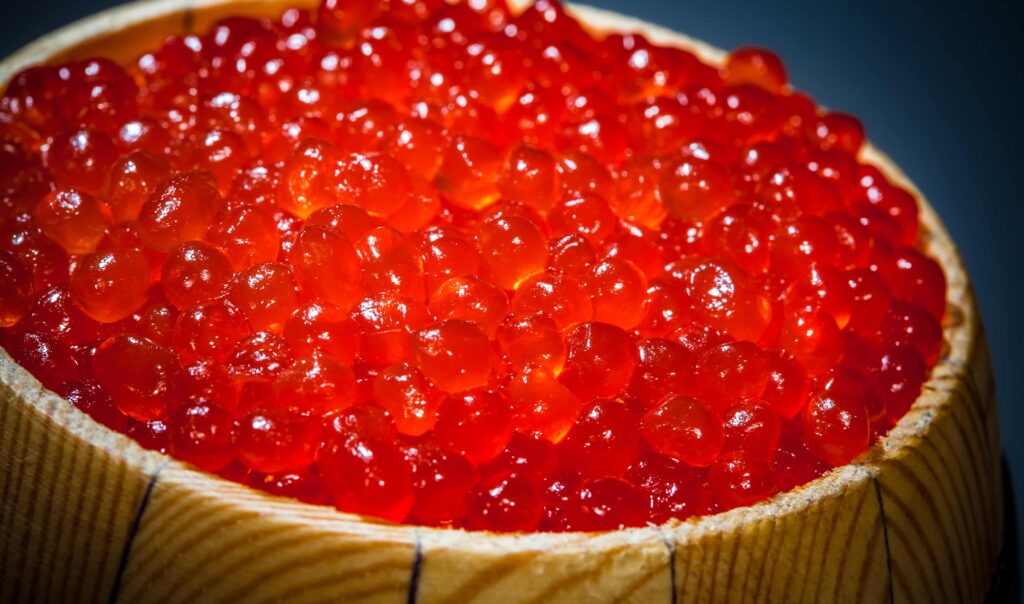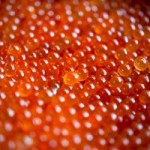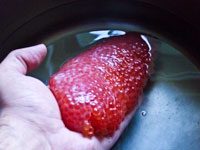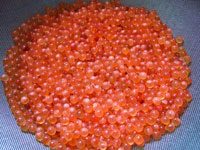Salmon roe, also known as ikura, is a bright orange delicacy loved by sushi aficionados The egg-filled pockets burst with salty, savory umami flavor when eaten. While you can buy salmon roe at the store, making it at home lets you control quality and customize flavors With just a few easy steps, you can make restaurant-worthy salmon roe using fresh salmon.
Overview of Salmon Roe
Before diving into the process let’s overview some key facts about salmon roe
-
Salmon roe comes from female salmon and is essentially salmon caviar.
-
It consists of small, egg-filled orange spheres that range from 4-6mm.
-
The eggs are held together in skeins by a fine membrane.
-
Salmon roe has a distinct pop when eaten and a salty, rich flavor.
-
It can be used as sushi, served on crostini, mixed into rice, and more.
-
Traditionally it is lightly salted to enhance the flavor.
With this background, let’s look at how to prepare salmon roe yourself.
Ingredients Needed
To make homemade salmon roe, you just need a few basic ingredients:
- Salmon roe skeins removed from a fresh female salmon
- Non-iodized salt
- Rice vinegar or sake (optional)
The key is starting with very fresh salmon roe as the quality depends heavily on how fresh it is.
Step-by-Step Instructions
Follow these simple steps for perfect salmon roe every time:
1. Extract the Roe
-
Carefully remove egg skeins from salmon and place in a colander.
-
Rinse briefly under cool water to remove blood or debris.
2. Drain and Dry Roe
-
Drain roe so no water remains on the surface.
-
Gently pat with paper towels to dry completely.
3. Lightly Salt the Roe
-
Sprinkle a pinch of salt over the roe.
-
Gently mix using fingers until just lightly coated with salt.
4. Cure the Roe
-
Place salted roe in a container and refrigerate for 1-2 days.
-
The salt will draw out moisture and firm up the eggs.
5. Rinse and Pat Dry
-
After curing, rinse roe under cool water briefly to remove excess salt.
-
Drain and pat dry thoroughly with paper towels.
6. Season (Optional)
-
You can add a splash of rice vinegar or sake for extra flavor.
-
Gently mix in seasoning so eggs are lightly coated.
And that’s it – your salmon roe is ready to enjoy! The curing process gives it the perfect salty, pop-in-your-mouth texture.
Serving Suggestions
Homemade salmon roe is extremely versatile. Here are some delicious ways to eat it:
-
On sushi rolls – Top rolls with salmon roe for extra richness.
-
Sushi hand rolls – Add to hand rolls wrapped with nori and rice.
-
Poke bowls – Mix into Hawaiian poke bowls along with salmon.
-
Salads – Toss into leafy green or grain salads.
-
Eggs – Fold into scrambled eggs or top deviled eggs.
-
Rice – Mix into sushi rice for homemade chirashi bowls.
-
Canapés – Top crostini or crackers for an elegant appetizer.
-
Flatbread – Add pops of color and flavor to naan or pizza.
However you use your homemade salmon roe, its unique texture and salty taste are sure to impress!
Tips for the Best Results
Follow these tips for perfect texture and flavor with your homemade salmon roe:
-
Seek out very fresh salmon roe for the best quality.
-
Handle the skeins gently to avoid breaking the membranes.
-
Dry roe thoroughly before salting so salt can cure evenly.
-
Use a very light hand with salt to avoid over-salting.
-
Cure roe in the refrigerator 1-2 days until firmer.
-
Rinse cured roe briefly to remove excess salt.
-
Pat roe completely dry before seasoning or serving.
-
Store cured roe in an airtight container up to 4 days.
Common Questions
If you’re new to making salmon roe at home, here are answers to some frequent questions:
What’s the best way to extract the roe?
Use a very sharp, thin knife to carefully slice the skeins away from the salmon cavity. Take care not to tear the delicate membranes enclosing the eggs.
Is salmon roe safe to make at home?
Yes, as long as you use extremely fresh sushi-grade salmon and follow safe handling guidelines, the homemade roe is completely safe to eat.
How long will homemade salmon roe last?
The cured roe will keep for 3-4 days stored in an airtight container in the refrigerator. For longer storage, freeze roe but note texture will soften when thawed.
Can you use salmon roe from other fish?
While sturgeon and trout roe is sometimes called salmon roe, genuine salmon roe can only come from salmon fish. For authentic flavor and texture, always use salmon.
Is salmon roe healthy to eat?
Yes! Salmon eggs are rich in healthy omega-3s, minerals, and protein. Eaten in moderation, they can be part of a healthy diet.
Sample Recipe to Try
Want to try making salmon roe yourself? Here is an easy sample recipe:
Ingredients
- 1 pound fresh salmon roe
- 1 teaspoon non-iodized salt
- 1 tablespoon rice vinegar
Instructions
-
Rinse salmon roe. Pat extremely dry with paper towels.
-
Sprinkle lightly with salt. Mix gently for even coating.
-
Cure roe 1-2 days refrigerated.
-
Rinse briefly and pat very dry.
-
Mix in rice vinegar until roe evenly coated.
-
Enjoy roe immediately or store cured up to 4 days refrigerated.
Now you can impress friends with homemade salmon roe using simple, natural ingredients.
The Takeaway
With a few easy steps, you can turn fresh salmon roe into a delicious delicacy. Salt-curing firms up the texture while seasoning enhances the rich, oceanic flavor. Handled gently and cured properly, homemade salmon roe has an unbelievable pop. Mix it into rice, add to sushi, or serve on crackers for an elegant appetizer. So next time you get extremely fresh salmon roe, give this homemade preparation a try.

How to Make Caviar from Roe | Fish Eggs:
I’ve always loved caviar. It has a slightly briny taste from the sea and a unique texture from the fish eggs. When you first put them loose on your tongue, they taste salty, and then when they pop open, they blast your taste buds with flavor. It’s not easy to find recipes or instructions that explain how to make caviar from fish eggs. I’m sure you’ve looked this up on the internet and seen how to make fish eggs into bait. This is not the technique you want to follow if you want to consume the resulting fish eggs. This recipe teaches you the culinary technique of Curing Salmon Roe, transforming the fish eggs into caviar.
This is a cooking technique (or “How To”) that will become a great base recipe because it shows you how to make caviar from salmon roe (eggs). If you fish for salmon or know someone who does, ask them if you can have their roe. Roe is only found in female salmon. If you can’t do this, call your local fishmonger in May, which is salmon season, and ask them to get you some. Curing Salmon Roe is the same as making caviar. The roe comes in egg sacks, also called a skein. The recipe is written for one skein, but it can be changed to fit as many skeins or egg sacks as you have on hand.
This culinary technique can be used with all types of pacific wild salmon (King [Chinnock], Silver [Coho], Red [Sockeye], Pink [Humpy] or Chum [Dog]). Not that the name would make you think so, but Chum salmon has some of the best roe to make caviar, as their egg sacks or skeins are full-flavored and large in size. It is important to also know where your salmon came from if it is wild salmon vs farm salmon and the variety of the salmon. Check out this link on salmon to understand this topic more.
Recently I have been asked many times about freezing the caviar. I haven’t tried this with this recipe, but I have made this Curing Salmon Roe recipe with frozen skeins or egg sacks before. Before making this recipe, I would put the skein or egg sack in the fridge for at least 24 hours to thaw. Once you’re done fishing, you could wash and dry the skeins or egg sacks, then freeze each one separately, making sure to get rid of as much air as you can. This would make it easier to make a lot of caviar at once, and the caviar would taste better. Most commercial examples of caviar are very salty. This is what made me come up with this recipe and the amount of salt to water, with less salt. Because it has less salt, this caviar doesn’t last as long in the fridge. If you know that the end result will taste saltier, you can add more salt to the brine.
A single salmon skein (egg sake) will weight around a pound and make about 16 ounces of salmon caviar. To get more information on wild Alaskan salmon, please check out our friends at Copper River Salmon.
Use this Curing Salmon Roe recipe to make your own ikura sushi if you like sushi and want to make it yourself.
Makes: 1 pound of Cured Salmon Roe | Caviar. This and all my recipes are scalable.

| Servings | Prep Time |
| 16 guests | 5 minutes |
| Passive Time |
| 30 minutes |
|
|
Curing Salmon Roe
|
- One salmon skein or roe bag, or about a pound of other fish roe or eggs
- 1 cup salt, kosher do not used iodized salt
- 3 quarts of water heated to 100°F (38°C) to 115°F (46°C)
- First, put the kosher salt and 3 quarts of 100°F to 115°F (38°C to 46°C) water in a stainless steel or glass bowl that can hold 3 ½ quarts. Whisk the mixture until the salt is completely mixed. Next, either take the skein or egg sack off the fish if you bought it at a fish market or take it off the fish yourself. Run cool water over the skein to get rid of any blood that is still on the sack.
- There is a thin layer that keeps the roe inside the bag.
- Add the sack to the brine mixture.

- It will change from a clear reddish orange to a cloudy orange color when you add the skein to the salt brine.
- This is the salt reacting with the membrane. Make sure the brine covers the whole skein. Let this sit for 30 minutes, to cure the eggs.
- Prepare a second bowl made of glass or stainless steel and a strainer or small colander to go in it. Take the skein out of the brine after 30 minutes. Save the brine for later use. Place the bag in the bowl and wash it under warm water to get rid of the brine.
- Next, the membrane needs to be removed. Pick up the membrane with your fingers and pull it away from you. Make sure the skein is under the bowl and strainer.
- Inside the sack are smaller membranes holding the eggs together. These also must be removed.
- After all the membranes have been taken off, the eggs need to be rinsed several times to get rid of any other membranes that might be on each one.
- A fine skimmer or other sieve will make this process.

- Once you’ve taken off all the shells and given the eggs a good rinse, drip the roe back into the salt brine you saved. The color of the eggs will turn from cloudy.
- To clear. Its like magic.

- Take the eggs out of the brine and put them in a clean glass jar. Keep this caviar in the fridge at 34°F (1°C) or below for 7 to 14 days.
- Put the jar in a container of crushed ice to keep it colder than a normal refrigerator is set to. This will help the caviar last longer. If you freeze the caviar, the texture will change.
- The finished Salmon Caviar is clear and bright, and it smells and tastes like the sea. It has a light salty taste that pops when the eggs break on your tongue.
